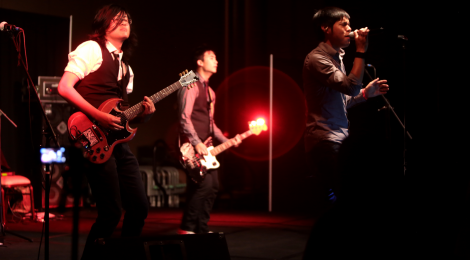
Matal v. Tam: Evolving Standards of Government Speech in the Music Industry
“Sorry if we try too hard / To take some power back for ours / The language of oppression / Will lose to education / Until the words can’t hurt us again”[1] sings Simon Tam on “From the Heart”—the lead track on the EP “The Band Who Must Not be Named.” This EP was released by The Slants in January of this year prior to the decision in Matal v. Tam (2017), a Supreme Court case which called into question constitutional protections for the government role in protecting offensive speech. Tam’s lyrics are a transparent reference to the pending litigation regarding the Patent and Trademark Office’s (PTO) denial of his trademark application for his band’s name. The PTO rightfully determined that the desired name, “The Slants,” was offensive hate speech because it makes a derogatory reference to Asian populations.
According to the PTO, the band’s name contradicts the disparagement clause of 1946’s Lanham Act, which established federal copyright, and states that “No trademark… shall be refused registration… unless it… may disparage… persons, living or dead, institutions, beliefs, or national symbols, or bring them into contempt, or disrepute.”[2] The historical and contemporary meaning of the name listed in the band’s application is a clear violation of the relevant statute, as the word “slants” wrongly disparages and discriminates against Asian populations. The Constitution, however, considers issues of hate and disparagement to be largely secondary to expansive freedoms of speech and expression. The issue of the case exceeds statutory application; the disparagement clause’s tension with First Amendment’s speech protections frames the legal issue.
The legal controversy emerged in 2011, when the PTO rejected Simon Tam’s application and prompted his lawsuit. Tam filed suit in the federal circuit, where he eventually won the case after an en banc hearing found the disparagement clause unconstitutional. The government appealed to the Supreme Court. A unanimous 8-0 court united behind the notion expressed in Justice Alito’s opinion that the PTO’s decision “offends a bedrock First Amendment principle: Speech may not be banned on the ground that it expresses ideas that offend.”[3] While the court sought to protect potentially offensive speech, it also sought to prevent government agencies like the PTO from extending any more than basic protections to harmful or offensive speech.
The definition of government speech rests at the center of the Matal v. Tam case. While the First Amendment limits governmental regulation of the public’s free speech, government speech is the doctrine which permits the government to undertake a viewpoint and articulate it and has no First Amendment limitations.[4] The guiding precedent for many government speech cases is Walker v. Texas Division, Sons of Confederate Veterans, Inc. (2015), wherein the Supreme Court decided that Texas had not discriminated against a neo-Confederate group by declining their request for a license plate featuring the Confederate Flag.[5] In situations as such, governments therefore are generally legally allowed to voice injustices, even when they cannot silence private individuals from the other side.
Government speech also played a supporting role in major Establishment Clause cases like McCreary v. ACLU, in which the Supreme Court held in 2005 that Kentucky could not display the Ten Commandments in its courthouses. In Justice Stevens’ opinion for the McCreary court, he wrote that “limits on governmental action that might make sense as a way to avoid establishment could arguably limit freedom of speech when the speaking is done under government auspices.”[6] Alito builds on the McCreary analysis, suggesting that “if private speech could be passed off as government speech by simply affixing a government seal of approval, government could silence or muffle the expression of disfavored viewpoints.”[7]
The opinion avoids citing the McCreary case, largely because it is unpopular among conservatives, and instead leans on the Supreme Court’s Pleasant Grove City v. Summum (2008) decision.[8] The Pleasant Grove court held unanimously that a local government could keep the Summum religious group from erecting a statue in a gallery of donated statues on the grounds that permanent edifices in parks were government speech that elected officials exercised final control over. If the government were considered to be involved in speech by anyone it issued a patent to, it could use the more stringent restrictions on itself to apply to political opponents or minorities. The parallel is not drawn explicitly, but the unanimous court of Matal v. Tam sides entirely with the divided McCreary majority.
In Matal v. Tam, it is evident that the party responsible for the distribution matters greatly in assigning it to a private or public actor. Content-based considerations also apply; the speech should in some way relate to the recognizable function of government. If, for example, the Slants created a song under contract for the PTO that explained the appeals process, that would constitute government speech. While the song referenced previously is about government and by a band bearing a government-sanctioned trademark, the fact that government involvement stops there separates The Slants sufficiently from the government itself.
The metric for free speech contains a gray area in the distinction between what constitutes government speech. While the courts articulate an issue-by-issue history of whether a government action speaks for the state, they do not place them on a continuum of permissibility. On one end lies the extremely mundane and procedural; cases like patents, marriages, and receipt of basic government services where government can rule with a clearer standard. Government cannot develop sufficient nuance at these levels to speak or be construed as officially endorsing any position. At the other end, there is room for ambiguity in instances of complex government entanglement—like selection of names and symbolism for programs and buildings or reports created by government agencies. Harder fought battles will occur in cases where the state grants privileges to only some private individuals. As this doctrine emerges, it must certainly include the Matal v. Tam precedent on the more guided part of the spectrum where the courts prevent government from speaking on nuanced issues through blunt bureaucracy.
[1] The Slants, “From the Heart,” 2017. Online. https://open.spotify.com/album/0H04LfCcuhAH6iOjWbSmHZ
[2]15 U.S. Code §1052(a) https://www.law.cornell.edu/uscode/text/15/1052
[3] Matal v. Tam, 2017 USSC No. 15-1293 pp. 1-2 https://www.supremecourt.gov/opinions/16pdf/15-1293_1o13.pdf
[4] “Government Speech,” Cornell Legal Information Institute. Web. https://www.law.cornell.edu/wex/government_speech
[5] Norton, Hellen. “Government Speech and Political Courage” 68 Stan. L. Rev. Online 61. October 2015. https://www.stanfordlawreview.org/online/government-speech-and-political-courage/
[6] McCreary v. ACLU 2005 USSC No. 03—1693. Web. https://www.law.cornell.edu/supct/html/03-1693.ZO.html
[7] Matal v. Tam, 2017 USSC No. 15-1293 p.14 https://www.supremecourt.gov/opinions/16pdf/15-1293_1o13.pdf
[8] Matal v. Tam, 2017 USSC No. 15-1293 p.13 https://www.supremecourt.gov/opinions/16pdf/15-1293_1o13.pdf




